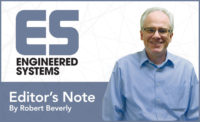Chaos and order, maybe even yin and yang … however you want to describe it, this year’s AHR and ASHRAE gathering reflected eternally opposing forces at work. On one hand, building professionals are readying (well, almost-readying) a significant consolidation for everyone working on and working toward greener nonresidential buildings.
On the other hand, the United States may have reached peak uncertainty with regard to the future of several HVAC regulatory particulars, thanks to bold and/or disruptive moves in places ranging from state legislatures to the White House to governing bodies abroad.
Let’s start with what is intended to make life a little simpler, shall we?
2018-IgCC Powered by 189.1
That is the name, simultaneously kind of modern and kind of bulky, of the latest development in model green code work. It has been in the pipeline for some time and was also the topic of the traditional Monday morning ASHRAE press breakfast, kindly hosted for us not at the association’s meeting hotel but in the convenient (and deep) recesses of McCormick Place.
So what’s going on here? As you might guess, it represents the fusion of Standard 189.1 with the IgCC — specifically, a merger of the 2015 IgCC and 2017 ASHRAE 189.1 — with a primary goal of increasing building sustainability by reducing confusion over multiple reference documents in the industry. Toward that end of unifying assorted efforts, the 2018-IgCC Powered by 189.1 is co-sponsored by ASHRAE, ICC, IES, and USGBC.
Let’s jump into details from a couple of the morning’s presenters.
THINK GLOBALLY, ACT LOCALLY
Dave Wells of ICC explained some of the primary objectives, elements, and benefits, some familiar within the context of 189.1 and some more recent.
- Emphasizing local adoptions of model codes.
- To that end, writing using enforceable language, suitable for reference by building codes and other regulations.
- Creating ICC administrative and enforcement structures behind 189.1.
- Rolling out significant education and training support, including on-site, online, and webinar materials working from a common PowerPoint deck.
- A web presence hosted by ASHRAE.
- Revision via continuous maintenance, including discrete changes (addenda), public review and approval, and the ability for anyone to submit a proposed change at any time.
The 189.1 section subjects break down into these categories:
- Site provisions to reduce landscape impact, address urban heat island phenomena, etc.
- Water-use provisions
- Energy use and efficiency provisions
- IEQ provisions
- Materials provisions (reduce/reuse/recycle)
- Construction and plans for operation to help the building operate as intended after occupancy
The 75 updates to 189.1 cover a lot of ground. All sections are updated to reflect updates to referenced standards, new technical information, and more practioner and enforcement experience, according to the group. Details and goals here include adding resilience to the scope in general and also requiring:
- Electrical infrastructure for EV parking/charging
- All water efficiency requirements, now mandatory and eliminating any performance option
- Real-time display of energy use
- Occupant IEQ surveys
Dave Walls, ICC’s executive director, sustainability, provided more perspective including a quick review of the timeline for 2018 IgCC. All addenda were incorporated into existing documents last fall. This winter has focused on ICC/ASHRAE meetings to consolidate the documents. The exact timeline for launch is still to be determined, but “spring/summer” of this year is the goal for publishing and releasing the actual document and rolling out the array of promotional efforts. Then looking ahead, the intent is to present results at the ASHRAE winter conference in Atlanta.
Looking westward can give some indication of how and where projects might benefit from this streamlined result, says Wes Sullens, USGBC Director of Technical Code Development. Sullens offered a lengthy list of LEED v4 prerequisites and credits that are now pre-approved for California commercial buildings that meet that state’s energy and green building codes (www.usgbc.org/green-codes). As you’d expect, quite a few are not directly HVAC related, but others regarding commissioning and verification, IAQ, and optimizing energy performance certainly are.
Sullens outlined how the USGBC is contributing promotional resources toward the collective goals of local code adoptions, including working directly with jurisdictions and developing tools that are consistent between LEED and USGBC.
Joe F. Winters, AIA, LEED AP is a principal at HOK Architects and the AIA’s organizational representative for this group. He reminded the audience that ASHRAE has appeals procedures for all who might feel aggrieved, and that 189.1 has mandatory requirements but also performance and prescriptive options.
Winters pointed out that the GSA used to piece together aspects of three different codes, so if you were working with them on a project, you had to know all three. Now, professionals will have to refer to just the one. He stressed that 189.1 has been crafted to coordinate well with both Standard 90.1 and the IECC.
COORDINATION, CONT’D
While we’re talking standards and outreach and such, I’ll pass along some subsequent news that ASHRAE has also launched a new online portal to improve user accessibility to the suite of resources related to ASHRAE Standard 90.1. ASHRAE describes the new destination:
Users can visit www.ashrae.org/901portal to set up login credentials and access the site. Once inside, users can personalize their experiences to access up-to-date features including the following.
- A multi-publication online tool that enables users to view each publication side by side or separately as well as copy, paste, print, or annotate content as needed.
- The ability to view official ASHRAE Interpretations in the context where they matter.
- Access to Standard 90.1 User’s Manual, which provides detailed instruction for design of commercial and high-rise residential buildings to ensure standard compliance. The user’s manual also includes measurements and calculations in both I-P and SI units, sample calculations, application examples, forms to demonstrate compliance, and references to related resources and websites.
- A redlined version of Standard 90.1 showing what changes were made from the previous edition.
That last one sounds like it could be especially handy every once in a while.
THE POLITICS OF HVAC
While the physics behind heating and cooling doesn’t change, the politics of it certainly can. Tuesday at AHR/ASHRAE began on the north edge of the Loop at the annual Danfoss press breakfast. One of the week’s more interesting aspects is often Mark Menzer’s update from his position as the manufacturer’s director of public affairs, and this year was no different.
The first year under a Trump administration had brought NAFTA, the Paris Climate Accord, the high-profile tax bill, and the EPA’s Significant New Alternatives Policy (SNAP) into the headlines. While the uncertainty and litigation surrounding the EPA’s stance toward banning HFCs has not been welcome through the industry, manufacturers not surprisingly are set to benefit from both the tax bill in general and the changes the new law heralds regarding expensing procedures.
That said, Menzer portrayed the situation as less rosy when it comes to the current EPA in general, citing a significantly eroded knowledge base, consequently pulling back on years of progress.
Returning focus to California, Menzer mentioned the state’s aggressive new refrigerant ban, set to kick in by 2021. By not only banning all high-GWP refrigerants but also declining to carve out any flexibility for existing equipment service scenarios, the new ban poses some implementation, compliance, and enforcement questions on the horizon.
Yet more questions surround the status of the Kigali Amendment, an international agreement reached in 2016 to limit HFCs. Menzer reports that 20 countries have approved the deal, which crosses its critical threshhold for taking effect. However, the Trump administration has not given any indication about whether it will support U.S. ratification, assuming it were to be introduced and would pass its Congressional hurdles. Putting it succinctly, Menzer’s assessment is that this uncertainty and failure to approve would put the U.S. tech lead in doubt.
After reeling off more of what you might categorize as Maybe’s — the idea that manufacturers might be held to overall corporate efficiency requirements for their equipment offerings instead of requirements for each individual unit, and what will happen with NAFTA? — Menzer could point to what he considers some good news: the survival of the Energy Star program. After it made headlines for about 20 minutes last year as a target for complete elimination in a proposed budget from the White House, cooler Congressional heads prevailed and Energy Star, as Menzer reports, seems to have escaped the axe ... for now.




